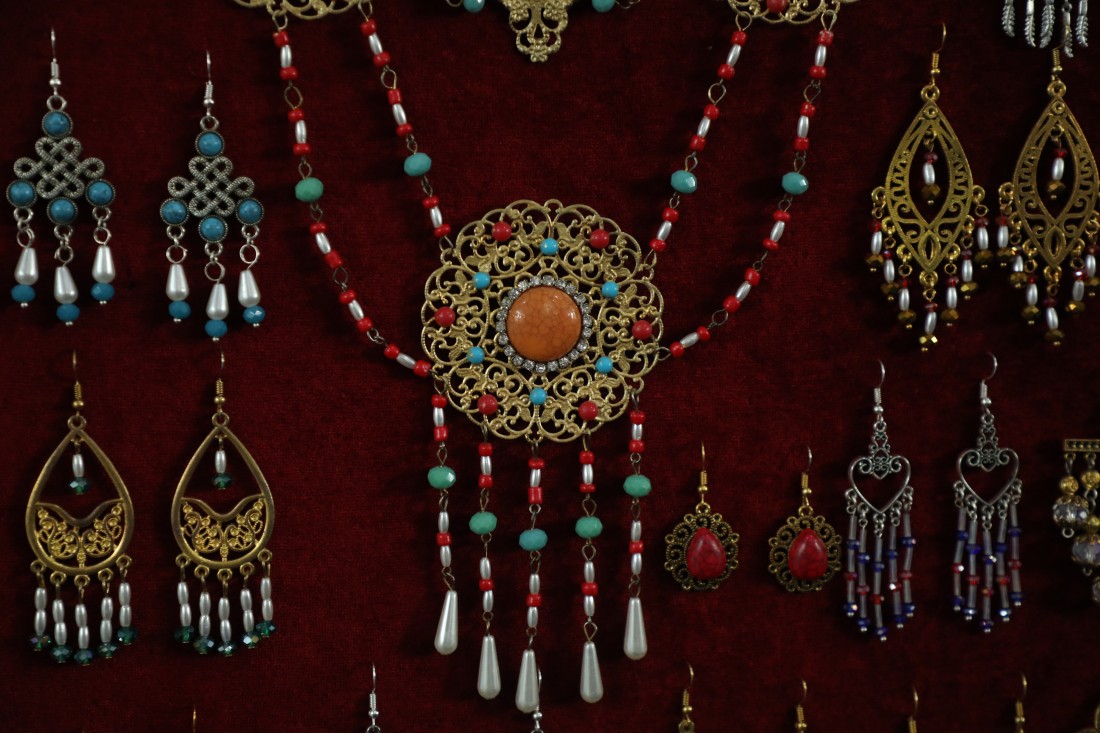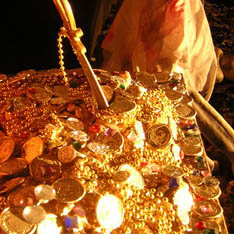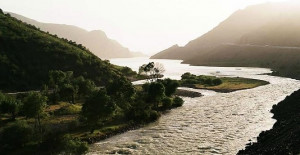Ancient Bukhara, as a true oriental city, keeps many secrets and legends associated with a unique culture, the change of civilizations and eras. Located in the Zarafshan valley, Bukhara has always been an object of interest not only for historians and scientists, but also for great commanders who have heard about the untold riches that this ancient land has kept in itself since ancient times.
The main income that fed the population of the Zarafshan valley was gold. Gold was a product of its own production. As historians testify, it has been mined here since the time of Ancient Bactria in the 4th century BC. e. It was gold mining that allowed ancient Bukhara to become one of the richest regions on the route of the Great Silk Road. Under the rule of the Sheibanids in the 16th century, they began to mint their own gold coins - ashrafi, which quickly forced out Arab dinars from the local market. Bukhara gold coins were widely used by local merchants in trade relations with Russia, Persia, and China.
Source article A.O. Bragin (St. Petersburg), O.A.Batrakov (Ulyanovsk): "Gold coins of Sheibanid Kuchkunchi Khan"
In the middle of the 19th century, the Hungarian Turkologist and traveler Arminus Vamberi lived in Bukhara under the guise of a dervish for a whole year. It was he who became the author of the invaluable publication "History of Bukhara" in 1872. Vamberi launched a noisy campaign in the largest European newspapers about the gold of Bukhara, where he told British readers about the mysterious Zarafshan River and local gold miners who daily take a pound of gold from the river. His publications were a big order from the ruling circles of England, who sought to launch an offensive policy against Russia in the struggle for a protectorate in Central Asia.
On the initiative of Vamberi, in 1878 Bukhara took part in the world exhibition in Vienna, where Bukhara gold items were presented, which delighted the Europeans. The newspapers wrote that the Zar-ofshon river flows in the Emirate of Bukhara, which means “golden stream”, which brings gold to its inhabitants. For Europe, Bukhara has become a real discovery, the center where many travelers aspired to.

At one time, the Russian Emperor Peter I showed interest in ancient Bukhara. He needed funds to end the war with Sweden. He sent two expeditions to Bukhara and Khiva under the command of Prince Bekovich-Cherkassky and Colonel Buchholz, who were supposed to bring information confirming the existence of these treasures. Both expeditions ended in failure.
At the end of the 19th century, Russia conquered Central Asia. The Russian Empire expanded its borders to Afghanistan and took possession of vast territories that stored huge reserves of gold and became a colonialist on a par with Great Britain and France. In 1878, having defeated the Emirate of Bukhara, Russia established its own protectorate here. It was here at the end of the century that groups of Russian military and explorers went in search of gold. In 1894, the Russian gold mining company Zhuravko-Pokorsky began its prospecting operations in Bukhara, followed by the English company Rickmers, who began to develop gold mines. Then, large deposits of gold were discovered in the mountains of the Bukhara Khanate, which brought success to both companies, because when mining gold, large nuggets often fell.
At that time, most of the inhabitants of the Bukhara Emirate were engaged in gold mining. All gold, under pain of the most severe punishment, was surrendered to the emir's treasury. In addition, for the right to mine gold, the gold digger had to pay a special tax to the Bukhara treasury. All the gold handed over to the treasury was melted and minted into royal Nikolaev chervonets. They were made from the highest standard and were highly valued outside the emirate. Thanks to the well-established gold storage system, the Emirate of Bukhara has become one of the richest states in Central Asia, but in partnership with the Russian Empire.
After the fall of the Romanov Empire in Russia and the establishment of Bolshevik power in Tashkent, the Bukhara Emir Alimkhan thought about the fate of his fortunes. These were not only gold coins, but various precious jewelry, expensive carpets, collections of ancient Korans written by calligraphers of the 15th-16th centuries. He gradually began to export his jewelry through the mountain passes to neighboring Afghanistan. But his fortune was huge, and even one caravan would not have been enough for transportation. Large railway trains were needed, but the railways were blocked by the Bolsheviks.
By agreement with the Tashkent Bolsheviks, on March 3, 1918, the Bukhara socialists, led by Faizulla Khodjaev, organized an uprising in Bukhara. The rebels captured the city of Kagan, where the administration of the Russian Novo-Bukhara Bank was located, in the warehouses of which the gold reserves of the Bukhara Emirate were stored. But the emir's troops were not going to retreat and repelled the attack of the Reds and the Bolsheviks had to retreat to Tashkent.
An interesting document was discovered by Tajik scientists, professor of history N. Nazarshoev and associate professor of historical sciences A. Gafurov, while working in the Russian State Archive of Socio-Political History. The document contains an inventory, printed on a typewriter, with a volume of 48 sheets, which listed the material values of the last Emir of Bukhara.
“December 22, 1920, i.e. almost four months after the emir was overthrown, members of the State Commission for Accounting for the Values of the Bukhara People's Soviet Republic (BNSR) Khairulla Mukhitdinov and Khol-Khodja Suleymankhojaev took the train to Tashkent and deposited the valuables belonging to the People's Commissariat of Finance of the Turkestan ASSR emir of Bukhara.
After the delivery of the valuable cargo, the State Commission drew up the corresponding Act in two copies, one of which was transferred to the Commissariat of Finance of the Turkestan Republic, and the second to the Nazirat of Finance of the BNSR.

The valuables that were indicated in the Act were packed in chests and bags. At autopsy, they were clogged with precious stones, money, gold, silver, copper, clothing. Of all this treasure, we will list only what, in our opinion, is of undoubted interest.
Precious stones were represented by diamonds, diamonds, pearls, coral. Of these: 53 large diamonds (weight not specified), 39 large diamonds (138 carats), more than 400 medium-sized diamonds (450 carats), 500 smaller than medium-sized diamonds (410 carats), small diamonds (43 carats). Total gems: 1041 carats, excluding 53 large diamonds.
Most precious stones are encrusted in gold items: 1 sultan with diamonds and pearls, 4 crowns, 3 pairs of earrings, 8 brooches, 26 rings, 26 ladies' watches, 37 orders, 11 bracelets, 53 cigarette cases, 14 belts with plaques, 7 stars (with 5 large and medium diamonds and 30 small ones), 43 female mirrors, the Order of the White Eagle with 13 diamonds, a breast portrait of Said Alimkhan with 10 large and 20 small diamonds, a plaque with 59 diamonds, the Order of St. Andrew the First-Called with 20 diamonds, 2 Orders of Vladimir 1st class with 20 diamonds and two trailers with 10 diamonds, 5 orders of Stanislav 1st class with 13 diamonds, Order of Alexander Nevsky with diamonds, Danish Cross with 14 diamonds, Serbian Eagle with 5 diamonds, badge "For 25 years of service" with 6 diamonds, 3 silver Persian stars with diamonds, 18 silver checkers with stones and enamel, silver buckle with 21 diamonds.
Gold is presented in the form of various decorations - 14 pounds (1p. \u003d 16 kg), placers - 10 pounds and 4 f. scrap with a total weight of 4p. and 2 f., 262 ingots - 12p. and 15 f., Russian coins of various denominations for a total of 247,600 rubles, Bukhara coins for a total of 10,036 rubles, foreign coins (1 f.). In general, the mass of gold in jewelry, placers, scrap, ingots, coins, orders amounted to 688, 424 kg.
There is an appendix to the Act, according to which all gold items and precious stones have undergone an expert assessment to determine their quality and weight. The estimate was given by the jeweler Danilson. However, interestingly, the weight of precious stones, gold and silver, determined by Danilson, is underestimated compared to that given in the Act itself.
According to historians, all this valuable cargo was transported through Samarkand to Tashkent in the mid-1920s, and from there most of it went straight to Moscow. Much was simply looted.
Emir Alimkhan, who fled through the Gissar mountains to Afghanistan, was waiting for support from Europe. So, in a letter to the King of Great Britain on October 12, 1920, he wrote that he hoped for the support of His Majesty in the fight against the Bolsheviks and was waiting for a loan from him in the amount of 100 thousand pounds sterling, 20 thousand rifles with ammunition, 30 guns with shells, 10 airplanes and 2 thousand soldiers of the Anglo-Indian army. However, England, which did not want to go to a direct aggravation with the Bolsheviks, fearing that they could continue their offensive and establish Soviet power in Afghanistan, did not begin to assist the emir.
The last of the Mangyt dynasty, Seyid Alimkhan, after immigration, lived the rest of his life in Afghanistan and died in Kabul on May 5, 1944.
Time erases the boundaries, revealing and shining through new facts in the history of mankind, and who knows how the fate of the last emirs of Bukhara and Khiva could have happened if Central Asia had been ruled not by the Russian Empire, but, for example, by the British. Be that as it may, life goes on as usual, and only the colorful pages of history tell about that uncompromising struggle for power and gold, the price of which was often human life.
According to the research materials of the historian, professor, doctor of historical sciences G.A. Khidoyatova.









Working hours: 9:00 AM - 6:00 PM, Mon-Fri
For any questions
ПОЛЬЗОВАТЕЛЬСКОЕ СОГЛАШЕНИЕ
1. Определение
Настоящее Пользовательское соглашение (далее — Соглашение) является Публичной офертой в соответствии со статьёй 367 Гражданского кодекса Республики Узбекистан от 21.12.1995 (https://lex.uz/ru/docs/111181#162763) и регулирует порядок использования материалов и Сервисов сайта Государственного унитарного предприятия «Национальный PR-центр» (далее — Предприятие), размещённого на веб-сайте и поддоменах Национального Туристического Информационного Центра: https://uzbekistan.travel/ (далее — Сайт).
Посетитель и (или) Пользователь подтверждает, что ознакомлен, полностью и безоговорочно принимает все условия настоящего Соглашения и обязуется их соблюдать.
Использование Сайта Пользователем означает полное принятие данного Соглашения «как есть» в форме акцепта.
Соглашение вступает в силу с момента посещения любой страницы Сайта и (или) регистрации на Сайте и действует бессрочно во время пользования Сервисами Сайта.
Настоящее Соглашение обязательно для исполнения всеми Посетителями и Пользователями без каких-либо изъятий и дополнительных согласований.
Пользователь обязуется самостоятельно проверять актуальную редакцию Соглашения на Сайте перед использованием Сервисов.
2. Предмет Соглашения
Предметом настоящего Соглашения являются правила использования материалов Сайта и предоставление Посетителю и (или) Пользователю возможности использования Сервисов Сайта.
Предприятие является правообладателем исключительных прав на Сайт в целом и на его составные части, включая все виды контента: логотипы, товарные знаки, тексты, статьи, аннотации, иллюстрации, фотографии, графику, аудио- и видеофайлы, пользовательские интерфейсы, дизайн, структуру, программы, базы данных.
Я прочитал(а) и соглашаюсь с условиями использования сайта и политикой конфиденциальности.
